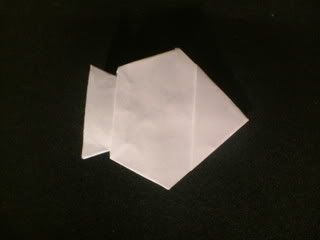This morning, I had one of my first experiences with rapid designing. It is april fool's day, and I decided that I should fold some fish to stick on the back's of my french teachers. The reason is in french, april 1st is "Poisson d'avril", where people stick paper fish on other peoples backs. Anyways, I used those rectangles that I get left over from copy paper (of which I have hundreds). I found out that using half of it works best, so I used a 4.75 by 2.5 inch rectangle. No CP, but I'll try my best at a good explanation. Fold one of the smaller edges over by about an inch. Then fold the corners at the folded edge back at 45° angles, touching on the folded edge. Fold the remaining rectangle section (the part not already folded at all) in half. Fold about a 22.5° angle on the top and bottom, with the angle starting where the 45° angles end. Inside reverse fold along those lines, and fold the flap that is behind as far a possible without adding extra folds. Then make the tail smaller, and you're done! Here is what mine looks like. Not bad for something made from a strange rectangle in 30 seconds.

It is also possible to edit it so that it has fins, a more detailed tail, etc. Because of the simple base, lots of variations are possible! Also, the head color changes if you use non-copy paper.





 The model does have a strange base, but you can tell where each of the parts come from. After folding the base, the leg section has to be squashed and the head part folded down. Then you can fold the head up and flatten it for the face, and form the tail, legs, arms and ears. the tail is color changed unless you fold the corner over the showing colored section.
The model does have a strange base, but you can tell where each of the parts come from. After folding the base, the leg section has to be squashed and the head part folded down. Then you can fold the head up and flatten it for the face, and form the tail, legs, arms and ears. the tail is color changed unless you fold the corner over the showing colored section.



